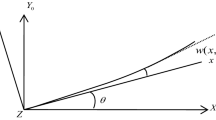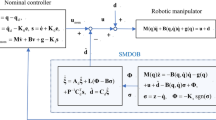Abstract
We estimated the reaction force for assembly work with a three-link dual-arm robot manipulator using sliding mode control with a sliding perturbation observer (SMCSPO) without using a force sensor. The sliding perturbation observer (SPO) is used to estimate the reaction force of the end effector without using any sensor. The SPO estimates the perturbation, which consists of the parameter uncertainties, nonlinear terms, and disturbances such as the reaction force. During assembly, the most effective perturbation term is close to the reaction force, so we assumed that the estimated perturbation is the same as the reaction force. The estimated perturbation was compared with the reaction force from the dynamics of the manipulator using a simulation with the SimMechanics toolbox of MATLAB/SIMULINK. The simulation results show the performance of the SMCSPO and that the reaction force can be estimated using the SPO without any sensor. The method can improve the structural reduction of link manipulator robots and decrease costs.
Similar content being viewed by others
References
K. Ohishi, M. Miyazaki, M. Fujita, and Y. Ogino, “Force control without force sensor based on mixed sensitivity H ∞ design method,” Proc. of IEEE Int. Con. on Robotics and Automation, pp. 1356–1361, 1992. [click]
K. Ohishi, M. Miyazaki, M. Fujita, and Y. Ogino, “H ∞ observer based force control without force sensor,” Proceedings of IEEE Int. Con. on Industrial Electronics, Control and Instrumentation, pp. 1049–1054, 1991.
K. Ohishi, M. Miyazaki, and M. Fujita, “Hybrid control of force and position without force sensor,” Proceedings of IEEE Int. Con. on Industrial Electronics, Control and Instrumentation, pp.670–675, 1992.
P. J. Hacksel and S. E. Salcudean, “Estimation of environment force and rigid-body velocities using observer,” Proc. of IEEE Int. Con. on Robotics and Automation, pp. 931–936, 1994.
T. Murakami, R. Nakamura, F. Yu, and K. Ohnishi, “Force sensorless impedance control by disturbance observer,” Record of the Power Conversion Conf., pp. 352–357, Apr. 1993.
P. J. Hacksel and S. J. Salcudean, “Estimation of environmental forces and rigid-body velocities using observers,” Proc. of IEEE Conf. on Robotics and Automation, pp. 931–936, 1994. [click]
A. C. Smith and K. Hashtrudi-Zaad, “Application of neural networks in inverse dynamics based contact force estimation,” Proc. of IEEE Conf. on Control Applications, pp. 1021–1026, Aug. 2005.
V. Zahn, R. Maass, M. Dapper, and R. Eckmiller, “Learning friction estimation for sensorless force/position control in industrial manipulator,” Proc. of IEEE Conf. on Robotics and Automation, pp. 2780–2785, May 1999.
J. W. L. Simpson, C. D. Cook, and L. Zheng, “Sensorless force estimation for robots with friction,” Proc. of Australasian Conf. on Robotics and Automation, Nov. 2002.
M. Van Damme, P. Beyl, B. Vanderborght, V. Grosu, R. Van Ham, I. Van-derniepen, a. Matthys, and D. Lefeber. “Estimating robot end-effector force from noisy actuator torque measurements,” IEEE International Conf. on Robotics and Automation, pp. 1108–1113, May 2011. [click]
Z. Liu, F. Yu, L. Zhang, and T. Li, “Real-time estimation of sensorless planar robot contact information,” Journal of Robotics and Mechatronics, vol. 29, no. 3, 2017. [click]
N. Likar and L. Žlajpah, “External joint torque-based estimation of contact information,” The Int. J. of Advanced Robotic Systems, vol. 11, pp. 1–11, 2014.
L. D. Phong, J. Choi, and S. Kang, “External force estimation using joint torque sensors for a robot manipulator,” Proc. of IEEE International Conference on Robotics and Automation, pp. 14–18, May 2012.
L. Chan, F. Naghdy, and D. Stirling, “An improved extended active observer for adaptive control of a n—DOF robot manipulator,” J. Intell Robot System, vol. 85, pp. 679–692, 2017. [click]
J. Qin, F. Leonard, and G. Abba, “Experimental external force estimation using a non-linear observer for 6 axes flexible-joint industrial manipulators,” Proc. of 9th Asian Control Conference, ASCC, Istanbul, Turkey, pp. 1–6, June 2013.
S. Lichiardopol, N. V. deWouw, and H. Nijmeijer. “Robust disturbance estimation for human–robotic manipulation,” Int. J. Robust Nonlinear Control, vol. 24, pp. 1772–1796, 2014. [click]
S. M. Yoon, W. J. Kim, and M. C. Lee, “Design of bilateral control for force feedback in surgical robot,” International Journal of Control, Automation, and Systems, vol. 13, no. 4, pp. 916–925, 2015. [click]
S. M. Yoon, M. C. Lee, and C. Y. Kim. “Sliding perturbation observer based reaction force estimation method of surgical robot instrument for haptic realization,” International Journal of Humanoid Robotics, vol. 12, no. 2, pp. 1–19, 2015.
J. Jung, J. Lee, and K. Huh, “Robust contact force estimation for robot manipulators in three-dimensional space,” Proc. of the Institution of Mechanical Engineers, Part C: Journal of Mechanical Engineering Science, pp. 1317–1327, Sep. 2006.
V. I. Utkin, “Variable structure systems with sliding modes,” IEEE Transactions on Automatic Control, vol. 22, pp. 212–222, 1977. [click]
N. Yagiz and Y. Hacioglu, “Fuzzy sliding modes with moving surface for robust control of a planar robot,” Journal of Vibration and Control, vol. 11, no. 3, pp. 903–922, 2005
P. Herman, “Sliding mode control of manipulators using first-order equations of motion with diagonal mass matrix,” Journal of the Franklin Institute, vol. 342, pp. 353–363, 2005
M. L. Corradini and G. Orlando, “Control of mobile robots with uncertainties in dynamical model: a discrete time sliding mode approach with experimental results,” Control Engineering Practice, vol. 10, pp. 23–34, 2002. [click]
S. Yannier, A. Sabanovic, A. Onat, and M. Bastan, “Sliding mode based obstacle avoidance and target tracking for mobile robots,” Proceedings of the IEEE International Symposium on Industrial Electronics, Dubrovnik, Croatia, pp. 1489–1494, June 2005.
G. Herrmann, S. K. Spurgeon, and C. Edwards, “A model based sliding mode control methodology applied to the HDA-plant,” Journal of Process Control, vol. 13, pp. 129–138, 2003. [click]
E. M. Jafarov and R. Tasaltin, “Robust sliding mode control for the uncertain MIMO aircraft model F-18,” IEEE Transactions on Aerospace and Electronic Systems, vol. 36, no. 4, pp. 1127–1141, 2000. [click]
A. Jameel, M. Rehan, K. S. Hong, and N. Iqbal, “Distributed adaptive consensus control of Lipschitz nonlinear multi-agent systems using output feedback,” International Journal of Control, vol. 89, no. 11, pp. 2336–2349, 2016. [click]
M. Siddique and M. Rehan, “A concept of coupled chaotic synchronous observers for nonlinear and adaptive observers-based chaos synchronization,” Nonlinear Dyn., vol. 84, pp. 2251–2272, 2016. [click]
S. Ahmad, M. Rehan and K. S. Hong, “Observer based robust control of one-sided Lipschitz non-linear systems,” ISA Transactions, vol. 65, pp. 230–240, 2016. [click]
S. Ahmad and M. Rehan, “On observer based control of one sided Lipschitz systems,” Journal of the Franklin Institue, vol. 353, pp. 903–916, 2016.
S. Nicosia and P. Tomei, “Robot control by using only joint position measurements,” IEEE Trans. Automat. Cont., pp. 1058–1061, Sep. 1990.
W. H. Zhu, H. T. Chen and Z. J. Zhang, “A variable structure robot control algorithm with an observer,” IEEE Trans. Robotics Automat, vol. 8, Aug. 1992.
R. L. Hollis, S. Salcudean, and P. A. Allan, “A six degreeof-freedom magnetically levitated variable compliance fine motion wrist: design, modelling and control,” IEEE Trans. Robotics Automat, vol. 7, pp. 320–332, June 1991. [click]
S. R. Oh, R. L. Hollis, and S. Salcudean, “Precision assembly with a magnetically levitated wrist,” Proc. IEEE Conf. Robotics Automat., Atlanta, USA, pp. 127–134, May 1993.
S. Salcudean, H. Davis, C. T. Chen, D. E. Goertz, and B. Tryggvason, “Coarse-fine residual gravity cancellation system with magnetic levitation,” Proc. IEEE Conf. Robotics Automat., Nice, France, pp. 10–15, May 1992.
S. Salcudean, N. M. Wong, and R. L. Hollis, “A forcereflecting teleoperation system with magnetically levitated master and wrist,” Proc. IEEE Conf. Robotics Automat., Nice, France, pp. 10–15, May 1992.
S. Salcudean, “A globally convergent angular velocity observer for rigid body motion,” IEEE Transactions on Automatic Control, vol. 36, pp. 1493–1497, Dec. 1991. [click]
C. H. An, C. G. Atkeson, and J. M. Hollerbach, Modelbased Control of a Robot Manipulator, MIT Press, Cambridge, MA, 1988.
Y. F. Zheng and J. Y. S. Luh, “Optimal load distribution for two industrial robots handling a single object,” Proc. of IEEE International Conference on Robotics and Automation, Philadelphia, USA, pp. 344–349, 1988.
P. Dauchez, X. Delebarre, Y. Bouffard, and E. Degoulange, “Task modeling and force control for a two-arm robot,” Proc. of IEEE International Conference on Robotics and Automation, Sacramento, California, pp. 1702–1707, 1991.
Q. Xue, A. A. Maciejewski, and P. C. Y. Sheu, “Determining the collision-free joint space graph for two cooperating robot manipulators,” IEEE Transactions on Systems, Man, and Cybernetics, vol. 23, no. 1, pp. 285–294, 1993.
A. Kron and G. Schmidt, “Haptic telepresent control technology applied to disposal of explosive ordnances: Principles and experimental results,” IEEE International Symposium on Industrial Electronics, Dubrovnik, Croatia, pp. 1505–1510, 2005.
N. Kimura, K. Ito, T. Fuji, and K. Fukimoto, “Mobile dual-arm robot for automated order picking system in warehouse containing various kinds of products,” Proc. of IEEE/SICE International Symposium on System Integration (SII), pp. 332–338, Dec. 2015.
H. Elmali and N. Olgac, “Sliding mode control with perturbation estimation (SMCPE),” International Journal of Control, vol. 56, pp. 923–941, 1993. [click]
M. J. Terra, H. Elmali, and N. Olgac, “Sliding mode control with perturbation observer,” J. Dyn. Syst. Measurement Control, vol. 119, pp. 657–665, 1997. [click]
L. T. Dung, H. J. Kang, and Y. S. Ro, “Robot manipulator modeling in Matlab-simmechanics with PD control and online gravity compensation,” IEEE. International Forum on Strategic Technology (IFOST), pp. 13–15, Oct. 2010.
T. D. Cho, S. H. Seo, and S. M. Yang, “A study on the robust position control of single-rod hydraulic system,” Journal of the Korean Society of Precision Engineering, vol. 16, no. 3, pp 128–135, 1999.
M. Jelali and A. Kroll, Hydraulic Servo-system: Modelling Identification and Control, Springer Science & Business Media, 2012.
S. M. Yoon, M. C. Lee, C. Y. Kim, and B. H. Kang, “Sliding perturbation observer based reaction force estimation method in surgical robot instrument,” Intelligent Robotics and Applications Lecture Notes in Computer Science, vol. 8102, no. 1, pp. 227–236, 2013. [click]
Author information
Authors and Affiliations
Corresponding author
Additional information
Recommended by Associate Editor Kyoungchul Kong under the direction of Editor Yoshito Ohta. This work was supported by the National Research Foundation of Korea (NRF) grant funded by the Korea Government (MSIP)(No.NRF-2012M2B2B 1055503) This research was supported by The Technology Innovation Program(10073147, Development of Robot Manipulation Technology by Using Artificial Intelligence) funded By the Ministry of Trade, Industry & Energy.
Karam Dad Kallu is working towards a Ph.D. degree in Mechanical Engineering from Pusan National University, Busan, Korea since 2015. He received the M.S and B.S degrees in Mechatronics Engineering from Air University, Islamabad, Pakistan, in 2013 and 2011, respectively. His research interests include nonlinear control, adaptive control, robust control, robot manipulator and system identification.
Wang Jie received the B.S. degree in Mechanical Engineering from Pusan National University, Busan, Korea in 2015. His research interests include nonlinear control, adaptive control, robot manipulator, robust control and system identification.
Min Cheol Lee received the Ph.D. degree in Applied Physics from University of Tsukuba, Tsukuba, Japan in 1991, his M. Eng. Degree in Engineering Science from University of Tsukuba, Tsukuba, Japan in 1988, and his B.S. degree in Mechanical Engineering from Pusan National University, Busan, Korea in 1983. His research interests include intelligent robot control, autonomous mobile robot, signal processing to identify a system, robust control of a vehicle driving simulator, sensor application, mechatronics, measuring three dimensional distance and object configuration using vision information.
Rights and permissions
About this article
Cite this article
Kallu, K.D., Jie, W. & Lee, M.C. Sensorless Reaction Force Estimation of the End Effector of a Dual-arm Robot Manipulator Using Sliding Mode Control with a Sliding Perturbation Observer. Int. J. Control Autom. Syst. 16, 1367–1378 (2018). https://doi.org/10.1007/s12555-017-0154-7
Received:
Revised:
Accepted:
Published:
Issue Date:
DOI: https://doi.org/10.1007/s12555-017-0154-7




